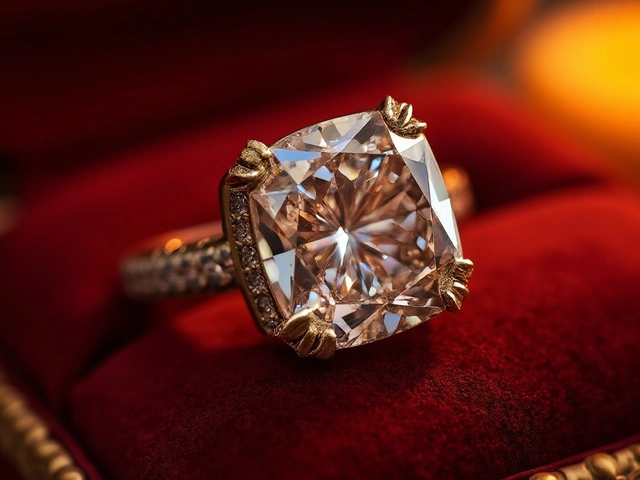
Thinking about a nose piercing? Before you take the plunge, it's important to know which spots on your nose should be avoided for piercing. This decision can impact not just your appearance but also your health. Noses aren't just for breathing—they're full of important structures and piercing the wrong area can cause issues.
In this article, we'll dive into the anatomy of the nose to identify sensitive areas you should skip. We'll also share tips on how to have a safer piercing experience, because nobody wants an infection as a fashion statement. Plus, we'll explore some creative nose pin designs to inspire your next look, keeping both style and safety in mind. Get ready to make informed decisions and flaunt your new piercing with confidence!
- Understanding Nose Anatomy
- Spots to Avoid for Piercing
- Tips for a Safer Piercing Experience
- Nose Pin Design Inspirations
Understanding Nose Anatomy
The human nose is a remarkable feature, both physiologically and aesthetically. It plays a vital role in breathing, filtering, and even our sense of smell. The nose is not just a singular piece but a multi-layered structure with bones, cartilage, and tissue, each playing its part in its unique functionality. When it comes to nose piercing, understanding the underlying anatomy is crucial. The nose is divided into two halves by the septum, which is primarily cartilage. The soft flesh at the nostrils, known as the ala, is one of the most common areas people opt for when piercing. However, choosing the right spot is key to avoiding unnecessary pain and healing complications.
The external nose can be divided into two regions – the bony upper part and the lower cartilaginous part. The bony part provides structure, while the cartilage offers flexibility. It's fascinating how these structures complement each other, but they also mean you must be careful where you place your piercing. The nose also contains many blood vessels, which are essential in warming the air we inhale through it. If a piercing accidentally hits a blood vessel, it could lead to excessive bleeding.
A renowned piercer once stated, "Understanding the anatomy of the nose is the first step to a successful piercing experience."
When planning a piercing, knowing about the inner workings can help you choose wisely. The inside wall of each nostril is lined with a delicate mucous membrane, which can be prone to infection if not cared for properly post-piercing. Thus, opting for a spot that's easy to clean and free from such sensitivities can be a game-changer. The nostril itself is made of lateral nasal cartilages, which add structure but must be approached with knowledge when pierced.
Common Piercing Areas
There are several common areas where people typically get their noses pierced. The nostril, known for its aesthetic appeal and simplicity in healing, is a preferred spot. The septum, although a bit trickier due to its central cartilage, offers a striking alternative that's increasingly in vogue. Then there's the less common, but intriguing, bridge piercing, which involves skin and tissue, not the cartilage, and is situated near the eyes.
Choosing a less intrusive area leads to minimal complications and an easier healing process. It's considered wise to consult with a professional piercer who has a thorough knowledge of nose anatomy and can guide you to a wise choice of piercing site. They often employ strategies like feeling for the 'sweet spot' in septum piercings, a softer area that's less populated by cartilage and more forgiving.
| Common Piercing Areas | Difficulty Level | Healing Time |
|---|---|---|
| Nostril | Moderate | 4-6 months |
| Septum | Advanced | 6-8 months |
| Bridge | Advanced | 8-12 months |
Spots to Avoid for Piercing
When you're deciding on a location for a nose piercing, it's tempting to pick the spot that looks best to you. However, it’s crucial to be cautious about where you plan to pierce. The nose is not just a canvas; it's a complex structure made up of cartilage and soft tissues. One of the key areas to avoid is the thick cartilage at the bridge of the nose. Piercing here can cause significant harm, because the cartilage does not heal in the same way as flesh. Unlike the softer septum, which is a common and safer area to pierce if done correctly, the bridge can give rise to migration and rejection. Not only can it be painful, but healing issues are prevalent too.
Another area many people don't consider is near the alar crease, the line where your nose meets your face. This spot is not only uncomfortable to pierce due to the dense tissue but can cause complications in healing because of its shape and function. Daily movements like smiling or frowning can irritate this kind of piercing, prolonging the healing process and increasing the risk for infection. In a similar vein, the tip of the nose is also not ideal. The skin is thinner and the proximity to cartilage can make it difficult to maintain if you're looking to use heavier jewelry such as a nose pin design that suits an everyday look.
Nose piercing complications are no small matter, and pros often mention these areas with caution. The risk of blood vessel puncture, although rare, is another consideration, particularly in the nasal tip area. An overlooked danger is the possibility of a misplaced piercing affecting your olfactory senses. It's worth noting that many professional piercers suggest avoiding overly unique spots, especially those that have no established piercing traditions or scant research on safety and healing times.
Renowned piercer Elayne Angel once said, "Choosing the right location for a piercing can mean the difference between a beautiful adornment and a painful ordeal." Her advice puts emphasis on understanding that not every spot is suitable, and expert guidance is worth seeking when venturing into less conventional placements.
Data surrounding piercings, like those collected by research on body modifications, suggests that these complications are not unheard of, especially when the piercing is done in less common or riskier areas. Data from a survey published by the Body Art & Health Journal indicates that placement complications account for 15% of all reported issues among individuals with facial piercings. Being smart about placement means being smart about safety.

Tips for a Safer Piercing Experience
Deciding to get a nose piercing is a big step, especially when it comes down to ensuring safety and hygiene. The first crucial step is selecting a professional piercer. Always choose someone who is reputable and has ample experience. Look for certifications, read online reviews, and, if possible, get recommendations from people you trust. A professional with a clean and hygienic studio can dramatically decrease the risk of infections. Ensure they use a fresh needle, not a gun, as guns can cause tissue damage and are harder to sterilize.
Once the piercing is done, aftercare becomes your main responsibility. Cleaning is essential, but avoid harsh chemicals like alcohol or hydrogen peroxide. Instead, rinse with saline solution or soap-free gentle cleansers. Apply these with clean hands; touching the pierced area with dirty hands is a no-no. According to Dr. Lisa Darsonval, a well-known dermatologist,
"A new piercing should be treated like a small wound, nurturing it through proper cleaning and patience."This means no swapping out jewelry too soon, as this can disrupt healing. Most importantly, listen to your body; signs of unusual pain, swelling, or discharge should prompt a visit to a healthcare professional.
Choosing the right jewelry helps too. Stick to hypoallergenic metals like stainless steel, titanium, or niobium. Avoid costume jewelry that can cause irritation or allergic reactions. Correct sizing is another vital factor. A piece that's too tight or too loose can lead to complications, including embedding or migration. When it comes to nose pin designs, simplicity can offer a more hassle-free healing process. Glamorous pieces often tend to snag on clothing or pillows, leading to unnecessary ouch moments.
A lesser-known fact is the timing of your piercing appointment can impact healing. Certain studies indicate that getting pierced in cooler months might aid recovery, as there's a reduced likelihood of sweating and subsequent irritation at the site. While this may not be a drastic influencer, it's worth considering if you have flexibility in your schedule. An analysis on the relationship between season and healing times published in the Journal of the American Medical Association provides intriguing insights:
| Season | Healing Time (Weeks) |
|---|---|
| Winter | 4-6 |
| Summer | 6-8 |
Ultimately, patience is the key. Nose piercings are enduringly trendy, but proper preparation and care will ensure that it's both a safe choice and a stylish one. Don’t rush the process; let your nose heal in its own time and you'll be able to enjoy your new fashion statement without hassle or worry.
Nose Pin Design Inspirations
Navigating the world of nose pin designs can be as thrilling as the decision to get pierced. With an array of styles available, from minimalist to extravagant, you'll find that each design has its own story to tell. First, let's talk about the classic stud. The simple beauty of a stud is unmatched and always a top pick for those who want to pay homage to tradition while keeping things understated. Made from materials such as gold, silver, or platinum, these are embellished with gemstones like diamonds or sapphires. Their elegance remains timeless in the world of fashion.
If you're seeking something with a touch of flair, a hoop might just be your calling. Hoops can vary slightly in size and thickness, offering a bit of versatility to the everyday look. You can choose a seamless hoop for a smooth silhouette or a captured bead ring that adds an element of interest. Historically, hoops have been symbolically significant in various cultures, often representing wealth and status.
For those ready to make a statement, the septum clicker is coming through strong. Its growing popularity can be attributed to its ability to blend edginess with elegance. A septum clicker is shaped like a small horseshoe, often encrusted with intricate designs. It snaps into place with a gentle click, making it easy to wear and remove. As reported by experts in the field of body modification, these designs can be worn comfortably without the weight sometimes associated with larger designs.
"Nose piercings have evolved beyond mere body art; they are expressions of personal style," notes a renowned body jewelry designer.
Let's not forget the unique beauty of L-shaped and fishtail pins, known for their versatility. The L-shaped post snugly fits inside the nose, making it a great option for new piercings or those who prefer a secure fit. On the other hand, the fishtail allows more customization, trimmed to fit perfectly. Nose piercing enthusiasts appreciate these because they are available in an array of decorative tops, from pearls and beads to intricate filigree work.
Now, if we glance toward the avant-garde, nose bridges and chains come into play. While not traditionally viewed as nose pins, they elevate the art of facial adornment. Nose chains, which connect a nose pin to an ear, can range from delicate chains to dramatic, bejeweled wonders. Bridging the gap, the nose bridge piercing sits across the top of the nose, creating a bold visual statement that truly caters to the more daring fashionistas.
Finally, take into account the vintage nose clip-on. This option allows wearers to experiment with designs without the commitment of a full-blown piercing. Emerging statistics show that there's been a rise in the popularity of non-pierce jewelry, with over 40% of survey respondents reporting positive experiences. This trend shows no sign of slowing down, offering those wary of needles a chance to embrace bold or subtle looks. Whether sticking to classic, low-key studs or venturing into bold territories with chandelier-style pins, nose pin designs hold endless possibilities to match any personality.



